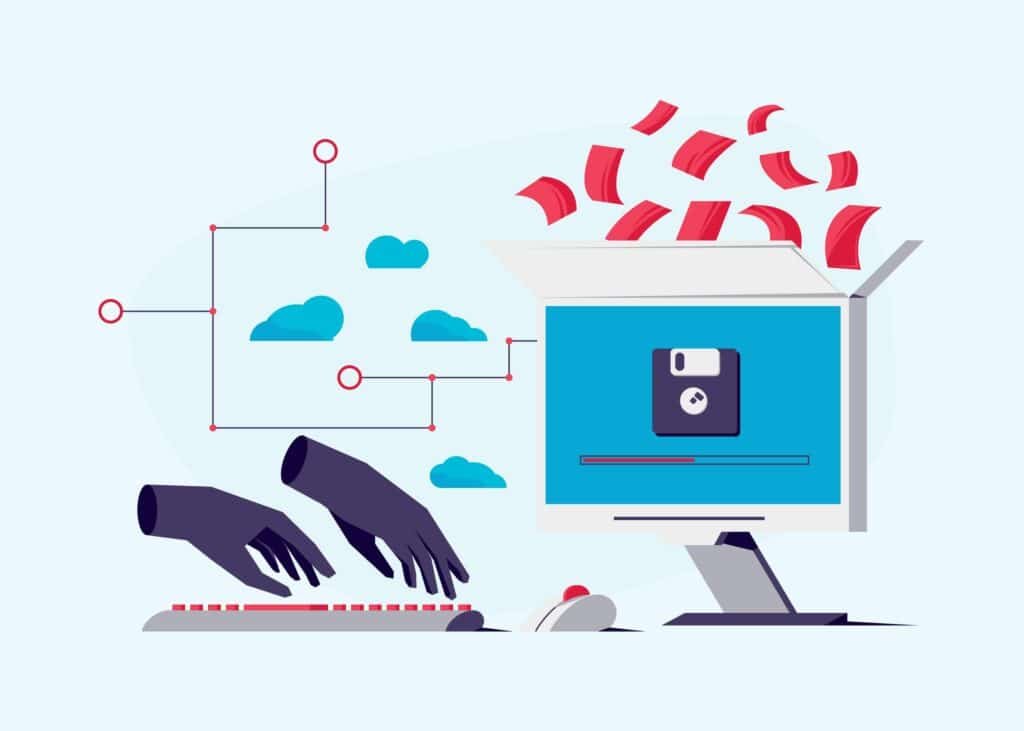What Is Data Exfiltration In Cyber Security?
Data exfiltration in cyber security is when someone illegally takes data from a computer or another device. It happens when sensitive, protected, or private information is copied, moved, or taken from a system without permission, often using harmful methods. This can happen in different ways, such as someone physically accessing a computer, remotely using malware, or tricking someone with social engineering tactics. Data exfiltration is a serious threat because it aims right at the important data that companies try hard to keep secure.
The reasons for data exfiltration are usually harmful, including spying on companies or stealing personal data to commit identity theft. In today’s world, where we use a lot of data-driven technologies and store huge amounts of digital information, the risks and possible damages from data exfiltration are bigger. That’s why it’s important to understand how it works, where it can come from, and how to stop it. Knowing the basics of data exfiltration can help organizations and individuals prepare to protect against these sneaky attempts to take valuable information.
What is Data Exfiltration?
Data exfiltration is when unauthorized people copy, move, or take sensitive, confidential, or very important information from a computer or server. This is a big problem in cyber security because it means that valuable data is being taken and could be used for making money illegally, gaining an advantage over competitors, or spying. Data exfiltration can happen in different ways, such as through malware, stolen passwords, or even physically stealing devices that hold sensitive data.
This process is usually very sneaky and can go unnoticed for a long time, letting bad actors keep taking data without being caught. Data exfiltration is a threat to big companies small businesses and individuals with personal details, financial records, creative work, or other important digital assets. Understanding how data exfiltration happens, spotting the signs of a breach, and taking strong steps to prevent it are crucial to protect yourself from this type of cyber attack.
How Data Exfiltration Occur?
Data exfiltration can happen in many ways, using different weaknesses in a network or system. A common method involves malware, which tricks users into downloading harmful files or takes advantage of security flaws. Once it’s on the system, this malware can quietly gather data and send it to the attacker. Phishing attacks are also common; in these attacks, employees are tricked into giving away their login details, which are then used to access and steal confidential information.
Another serious threat is called Advanced Persistent Threats (APTs). In these attacks, cybercriminals get deep into networks and stay hidden for a long time. They carefully collect data, often setting up automated systems to send the data back slowly and quietly so they don’t get caught. Physical threats exist too, like when someone unauthorized enters a place and copies data onto things like USB drives.
Network intercepts, also known as man-in-the-middle attacks, happen when someone secretly takes over legitimate conversations or data transfers on a network. The data is sent to the attacker instead of the person it was supposed to go to. This situation shows why it’s so important to have strong cybersecurity measures that not only protect with technology but also teach employees about the dangers and warning signs of potential data theft attempts.
What are the Techniques and Tools Used in Data Exfiltration?

The methods and tools used for data exfiltration vary a lot, from complex software to basic tricks that fool people. Cybercriminals usually use a combination of technical tools and methods that manipulate people (known as social engineering) to carry out their plans. Here are some common techniques and tools used in data exfiltration:
- Malware and Spyware: These are harmful software programs designed to sneak into systems unnoticed. Once they’re in, they can record what keys you press, watch over data, and send information back to the person who launched the attack. Examples include keyloggers, which track everything you type, and remote access trojans (RATs), which give attackers remote control of your computer.
- Phishing: This method involves sending fake emails that look like they’re from trustworthy sources to trick people into giving away private information or downloading harmful software. Spear phishing is a more targeted form of phishing that aims at specific people with personalized messages to make them more likely to fall for the scam.
- Command and Control Servers (C&C): Attackers use these remote servers to communicate with and control the systems they’ve compromised within a target network. These infected systems are then told to send stolen data back to these servers.
- Data Exfiltration over Physical Media: USB drives or other portable storage devices can be used to physically take data out of a secure place. This method is straightforward and can work very well if there aren’t good physical security measures in place.
- Cloud Storage Services: Cybercriminals might illegally access someone’s cloud storage accounts to quietly move data out of the company network without needing to use the company’s systems, which makes it harder to catch them.
- Encrypted Channels: To stay hidden from network monitoring tools, data is often sent out over secure, encrypted connections, like HTTPS or through VPN tunnels. This makes the data look like normal, secure web traffic, which is less likely to raise suspicions.
Understanding these methods and tools is key to creating a good defense plan against data theft. It’s important not just to rely on technology but also to teach employees how to spot and deal with cyber threats.
Impacts of Data Exfiltration
The effects of data exfiltration can be serious and wide-ranging, affecting an organization in many ways. Here are some of the main impacts:
- Financial Loss: When data is stolen, it can lead to big financial losses. This might happen directly, like when banking details or secrets that help the business succeed are taken, or indirectly, due to fines and penalties for not following data protection laws like GDPR or HIPAA. Besides, companies often spend a lot of money on checking what went wrong, fixing their systems, and making their security better after a breach.
- Reputational Damage: One of the worst effects of data exfiltration is losing the trust of customers and partners. A security breach can ruin a company’s reputation, leading to a loss of business and making the brand less valuable. Customers are less likely to trust a company that can’t protect their personal or financial information.
- Legal and Regulatory Consequences: Companies have legal duties to keep sensitive data safe. Data breaches can lead to lawsuits from people affected and penalties from regulators, which can mean large fines and legal costs.
- Operational Disruption: After a data theft incident, a lot of resources might need to be used to handle the situation. This includes managing public relations crises, and legal issues, and putting in place new security measures quickly. All this can interrupt regular business activities and reduce productivity.
- Intellectual Property Theft: For companies that depend on their own technology or creative products, losing intellectual property to theft can let competitors get ahead unfairly. This can greatly weaken a company’s competitive strength and position in the market.
Understanding these effects shows how important it is to have strong security rules and to take action before data theft happens, making sure all kinds of assets are well protected.
Detecting Data Exfiltration
Detecting data theft can be tough because these attacks are often sneaky, but with the right tools and strategies, organizations can get better at spotting suspicious activities before they cause big problems. Here are some effective ways to detect data exfiltration:
- Network Monitoring: Using advanced tools to watch network traffic and spot unusual patterns can be very helpful. These tools can catch strange spikes in data flow or data being sent to suspicious internet addresses.
- Data Loss Prevention (DLP) Software: DLP systems are built to spot possible security breaches and stop sensitive information from being sent out of the network. They protect private and important data and look for any actions that break set rules.
- Endpoint Security Solutions: These include tools to fight malware and systems to detect and prevent intrusions, which watch devices connected to the network for any odd behavior. Modern tools use machine learning to better recognize unusual activities that might mean data is being stolen.
- User and Entity Behavior Analytics (UEBA): UEBA tools analyze big data to monitor and assess user behavior, comparing it to normal patterns. Any deviations from these patterns might suggest a security issue, including data theft.
- Security Information and Event Management (SIEM) Systems: SIEM systems gather and organize log data from an organization’s entire tech infrastructure like host systems, applications, networks, and security devices. They provide real-time analysis of security alerts.
- Forensic Analysis: After a suspected security breach, forensic tools can trace the activities involving the data to figure out how, when, and by whom the data was accessed or stolen.
Setting up detection systems in advance and regularly updating security policies are crucial for staying ahead of cyber threats. Training employees to spot phishing and other common tricks used by attackers is also key to preventing data theft.
Legal and Regulatory Considerations
Understanding the legal and regulatory rules is very important when dealing with data theft, as the consequences can go beyond just the immediate security issue. Different places have strict laws on how data should be managed, and not following these laws can result in big fines. Here are some important legal and regulatory things to consider:
- General Data Protection Regulation (GDPR): For businesses operating in or handling data from people in the European Union, GDPR sets strict privacy and security rules. It requires strong protection of personal data and quick reporting of any breaches, usually within 72 hours of finding out.
- Health Insurance Portability and Accountability Act (HIPAA): In the United States, HIPAA protects the privacy and security of health information. Organizations that deal with protected health information (PHI) must have strong protections in place to prevent unauthorized access, like data theft.
- Payment Card Industry Data Security Standard (PCI DSS): This standard requires security measures for all organizations that handle credit card information. They must ensure that payment data is encrypted, access is controlled and watched, and security systems are kept up to date.
- California Consumer Privacy Act (CCPA): Similar to GDPR, the CCPA gives broad privacy rights to consumers and places strict rules on businesses about how they collect, use, and protect personal information from California residents.
- Sector-Specific Regulations: Depending on the industry, there may be additional rules to follow. For example, the financial sector in many countries has regulations that demand strong data protection and specific procedures for reporting data breaches.
- International Considerations: For companies that operate in multiple countries, data theft incidents can involve different legal areas, each with its own compliance rules and penalties. It’s crucial to understand these details to create a thorough data protection strategy.
Organizations need to follow these regulations and also keep up with new laws that might affect how they handle and protect data. Regular checks, both from inside and outside the company, can help make sure they’re following the rules and reduce the risks related to data theft.
In conclusion
In conclusion, data exfiltration is a major challenge for organizations in all sectors, posing risks to financial and operational stability as well as to the trust and privacy of customers and business partners. Understanding how attackers steal data, spotting the signs of a breach, and using effective detection methods are crucial steps in protecting sensitive information. Also, following legal and regulatory rules is vital for staying compliant and avoiding legal problems. By promoting a culture of security awareness and constantly improving cybersecurity defenses, organizations can greatly reduce the risk of data exfiltration and strengthen their ability to handle this widespread cyber threat.
FAQs
What exactly is data exfiltration?
Data exfiltration is when data is illegally copied, transferred, or retrieved from a computer or server without authorization. It’s like someone sneaking into your digital files and walking away with your secrets!
How does data exfiltration occur?
It can happen in various ways, including through malicious software (malware), phishing attacks, or even by someone with insider access, like a disgruntled employee, who decides to take data out of the company.
What are the common methods used for data exfiltration?
Cybercriminals are quite crafty and use several methods such as emails, cloud storage uploads, or even USB devices to sneak data out. They might also use more complex techniques like data being encoded into video or audio files.
Can data exfiltration happen accidentally?
Yes, sometimes employees might unknowingly cause data exfiltration by falling for phishing scams or by mishandling data, like sending sensitive information to the wrong email address.
What signs might suggest that data exfiltration is happening?
Keep an eye out for unusual network activity, strange outgoing traffic, or unexpected emails sent from your accounts. If your files are accessing odd hours or there are unrecognized downloads or uploads, these might be red flags.






